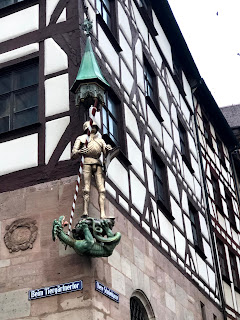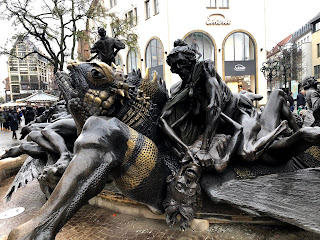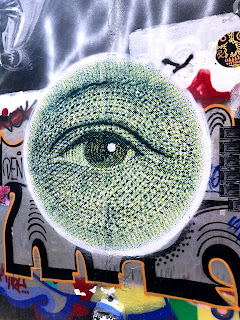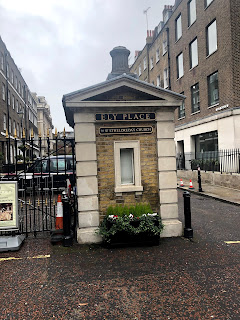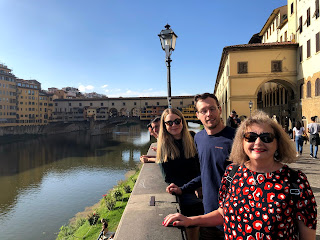“In the valley of the Pegnitz, where across broad
meadow-lands
Rise the blue Franconian mountains, Nuremberg, the ancient,
stands.”
This is the opening stanza of Longfellow’s poem,
Nuremberg. I came across this poem when
I was researching my blog and found its description of the city as relevant
today as it was when it was written more than a century and a half ago. Michael and I traveled to Nuremberg with the
main goal of seeing the Christmas markets.
I would have to say though that the markets were out shone by the beautiful
city.
Nuremberg is a very old city of cobble stone streets, large
churches and cathedrals, many statues and fountains all overlooked by the
castle on the hill. It is a truly
beautiful city to wander around and the Christmas markets were possibly the
best we have seen in Germany. We sampled
as much of the local specialties as possible including Lebkuchen, a delicious
gingerbread like cookie. We also tried
the Nuremberg sausage, a tasty sausage that must not be longer than 9cm and
weigh no more than 25g. They were
generally sold in a bun containing 3 sausages and were seriously moreish. Another delicacy we tried was the Kniekuchla
(knee cake), so named because the bakers used to stretch the dough across their
knees. They were served deep fried and
dusted with icing sugar. It is safe to
say that we did not go hungry during our stay.
We did find some cultural activities aside from eating. We chose to walk up the hill to the Imperial
Castle of Nuremberg and, as we were ascending the steep slope, snow started to
fall.

It was quite a heavy fall of snow and the streets were soon covered giving the city a fairy tale like appearance. The castle itself is an imposing structure with the first fortified buildings constructed around 1000.


The fortress expanded over the years, with modifications added and then a huge part of it was destroyed in World War II.


It has now been rebuilt and restored and we spent a long time exploring the various rooms and exhibits. It was magical to look out of the windows and see the snow-covered city from this high vantage point.

It was quite a heavy fall of snow and the streets were soon covered giving the city a fairy tale like appearance. The castle itself is an imposing structure with the first fortified buildings constructed around 1000.


The fortress expanded over the years, with modifications added and then a huge part of it was destroyed in World War II.


It has now been rebuilt and restored and we spent a long time exploring the various rooms and exhibits. It was magical to look out of the windows and see the snow-covered city from this high vantage point.
One of Michael’s favourite artists, Albrecht Durer, was born
in Nuremberg and we were lucky enough to visit the house where he lived and
worked for nearly 20 years. The house is
one of the few surviving burgher houses and was built around 1420.


The home was damaged in an air raid during World War II with bombs landing nearby blowing the roof off and knocking out the windows and some exterior walls, however, luckily, it did not catch fire. The house was subsequently restored and re-opened as a museum. The museum was beautifully presented, displaying copies of Durer’s paintings with a workshop set up where you could see the historical printing techniques.


The home was damaged in an air raid during World War II with bombs landing nearby blowing the roof off and knocking out the windows and some exterior walls, however, luckily, it did not catch fire. The house was subsequently restored and re-opened as a museum. The museum was beautifully presented, displaying copies of Durer’s paintings with a workshop set up where you could see the historical printing techniques.
A short train journey took us to the World Heritage City of
Bamberg. The city rests on seven hills
and is known as the “Rome of Franconia”.
It is an incredibly beautiful city that appears to have been lifted from
the pages of Grimms’ Fairy Tales. We spent a lovely day wandering up and down
the hills admiring the mediaeval buildings, churches and town squares.


The River Regnitz winds through the town with the old town hall built in the centre of the river. There were also a number of Christmas markets in various locations adding to an already wonderful atmosphere. The highlight for Michael was trying a Rauchbier (smoke beer). The malt for the beer is roasted over a beech wood fire instead of being dried in an oven giving the beer a unique flavour, which is often described as “liquid bacon”. It really was delicious.


The River Regnitz winds through the town with the old town hall built in the centre of the river. There were also a number of Christmas markets in various locations adding to an already wonderful atmosphere. The highlight for Michael was trying a Rauchbier (smoke beer). The malt for the beer is roasted over a beech wood fire instead of being dried in an oven giving the beer a unique flavour, which is often described as “liquid bacon”. It really was delicious.
Next stop on our Christmas jaunt was Munich. It is always fun to visit this city but
especially so during the festive season when the city comes alive with
Christmas markets. Our hotel room was a
pleasant surprise - a luxurious suite of rooms spread over two floors. We have
no idea why we were upgraded to such style, however it was much
appreciated. We spent a lovely couple of
days roaming the now familiar streets, spending time visiting the markets and
generally enjoying the Bavarian hospitality of the city.

Of course, no visit to Munich would be complete without dining at Michael’s favourite restaurant, Wirtshaus Zum Straubinger. Naturally Michael ordered the Schweinshaxe and the meal did not disappoint.


Of course, no visit to Munich would be complete without dining at Michael’s favourite restaurant, Wirtshaus Zum Straubinger. Naturally Michael ordered the Schweinshaxe and the meal did not disappoint.





